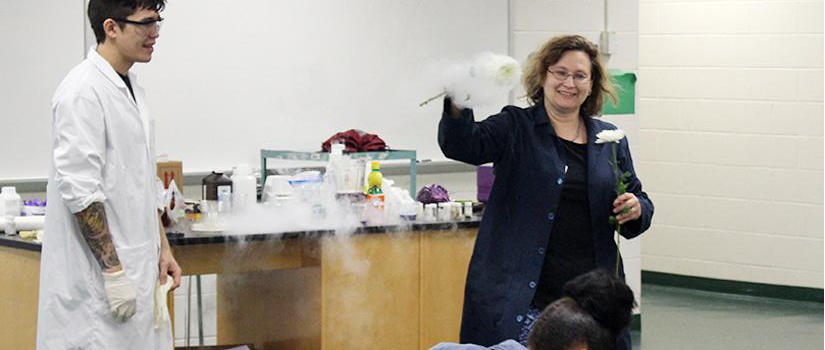Interactions and Chemical Demonstrations for K-12 School:
Professor Linda Shimizu initiated and developed a K-12 outreach program, the first of its kind at the USC. The program began in 2000 with initial funds from SC EPSCOR1, and has been subsequently supported by Shimizu and by her NSF grant. Graduate students, post-docs, and faculty help the Chemistry Outreach Program kindle the scientific interests of the next generation.
Trained by Shimizu, the program pairs volunteers with teachers in SC Midland's elementary, middle and high schools. Volunteers contact teachers, discuss how experiments relate to science standards, and exchange ideas on how to enhance the concepts that teachers are covering in their classes. They then visit K-12 schools to present ~50 minute chemistry demonstrations designed to showcase the scientific method. The experiments and the discussions are geared to the curriculum standards of 2nd (states of matter, magnets), 5th (mixtures and solutions), 7th (introductory chemistry), and high school chemistry.
A collection of experiments have been established, that other USC faculty borrow to use in their undergraduate lectures; these experiments are refinished and updated often. Nearly half of involved schools have high minority enrollments and students are surprised to meet "a real scientist". Response from students and teachers has been extremely positive.
Shimizu will continue to develop methods to evaluate and fine-tune presentations to meet the diverse needs of the community. If you are interested in participating in the program, please email Professor Shimizu (shimizls@mailbox.sc.edu) directly.
| Experiments | Concepts |
|---|---|
| Polyneoprene vs polynorbornene balls | Observations and physical properties |
| Iodine clock reactions | Chemical reactions/rates/equilibria |
| Tollins test | Chemical reactions/solutions/electroplating |
| Extract indicator from red cabbage | Natural products |
| Test products with pH Indicator | Classification and pH |
| Comparing ice, dry ice and liquid N2 | States of matter, temp., thermometers |
| Synthesis of nylon | Solutions and polymers |
| Polyvinylalcohol & cross linker | Physical properties of polymers |
| Extraction of DNA from banana | Genetic information, polymers |
| Sodium polyacrylate | Hydroscopic/ volume not conserved |
| Fluorescence of fluorescene, detergents, and tonic water | Organic molecules and fluorescence |
| Light sticks | Chemiluminescene |
1 EPSCOR is an Experimental Program to Stimulate Competitive Research.
